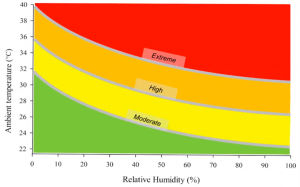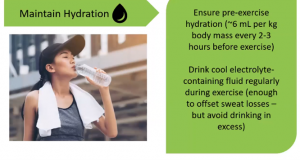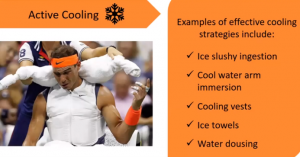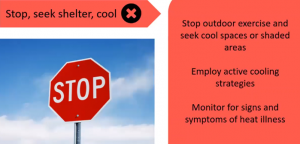01 Feb Exercising in extreme heat
As we enter the hottest month of the year, it is important to consider how we can stay safe while exercising in extreme heat conditions. Sports Medicine Australia (SMA) have developed a new policy and accompanying App which provides guidelines and advice on how best to mitigate the effects of extreme heat during exercise. Below are some of the key points from a recent webinar unveiling the guidelines.
Why have a heat policy?
Exercise causes a rise in the body’s core temperature. Exercising in hot environments can elicit a spectrum of heat-related illnesses which can have adverse effects on an individual’s health.

Heat syncope is a fainting episode.
Heat exhaustion is characterised by
- High heart rate
- Dizziness
- Headache
- Loss of endurance/skill/confusion
- Nausea
Heat stroke is POTENTIALLY FATAL. Characteristics are similar to heat exhaustion but with dry skin, confusion and collapse
How does the body regulate temperature during exercise?
In response to elevated core temperature during exercise, the human body has mechanisms to release heat energy to maintain a stable internal environment. When exercising in extreme heat conditions outdoors, evaporation of sweat is the only mechanism available to allow heat loss from the body.
How does heat stress occur?
Heat stress occurs when evaporative cooling mechanisms are impeded or overwhelmed. This results in toxins being released from the gut and causing a cascade of effects leading to strain on multiple organs of the body.
Is a heat policy as simple as determining a temperature cut-off?
It is not that simple, because there are six parameters which determine how the body heats up.
Four environmental factors:
- Air temperature (measured in the shade)
- Radiant temperature (thermal radiation directly from the sun)
- Air Velocity (wind)
- Humidity (concentration of water vapour in the air)
Two personal factors:
- Activity (intensity of activity determines degree to which core temperature rises)
- Clothing & equipment (potential barriers to evaporative cooling)
It is important to note that evaporation, NOT production, of sweat allows the body to shed excess heat. Therefore, conditions which facilitate evaporation are more conducive to reduced risk of heat stress. A hot, dry & windy day may have lower risk of heat stress than a more mild, still & humid day.
What are the guidelines?
This visual resource outlines the potential risk for athletes developing heat stress.

Universal guidelines are difficult to implement across a range of sports due to differing heat exposure, intensity of activity and clothing requirements. The thresholds can be slightly adjusted depending on these factors. Researchers associated with SMA have been developing an App allowing users to enter this information and access the most accurate adaptation of the guidelines.
What are heat stress mitigation strategies?
These strategies are designed to minimise the risk of athletes experiencing heat stress. The colours for each intervention correspond with the different zones of heat stress risk from the graph above.

Some key points are outlined below. It is important to emphasise that many of the active cooling strategies are easy and cost-effective to implement in a range of settings.



As more research is conducted and expert knowledge evolves in this important area, the guidelines will be updated. This includes for different population groups (children & youth athletes, athletes with a disability & masters athletes). As soon as the guidelines are published, we will make them available.
References:
SMA Webinar “New evidence and guidance for safe sport in extreme heat conditions” 3rd December, 2020.
ABC Radio National “Sporty” Podcast 5th December 2020
Google image (heat illness continuum) obtained from:
Other images:
SMA Webinar “New evidence and guidance for safe sport in extreme heat conditions” 3rd December, 2020.


